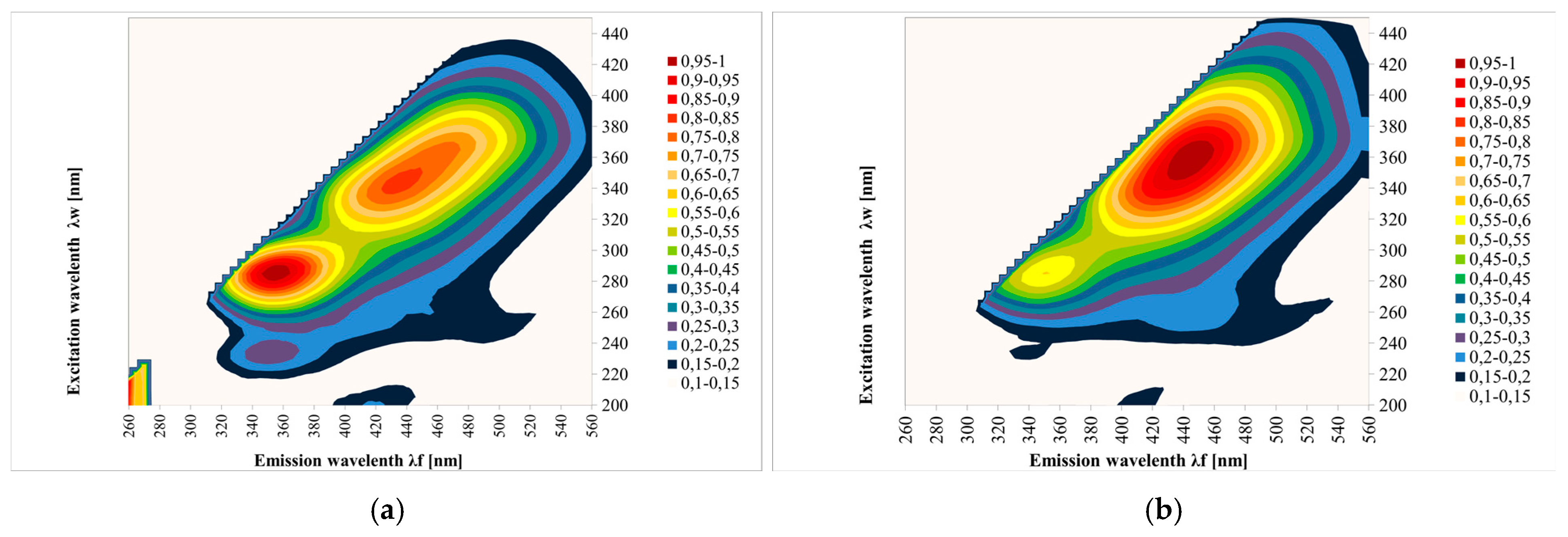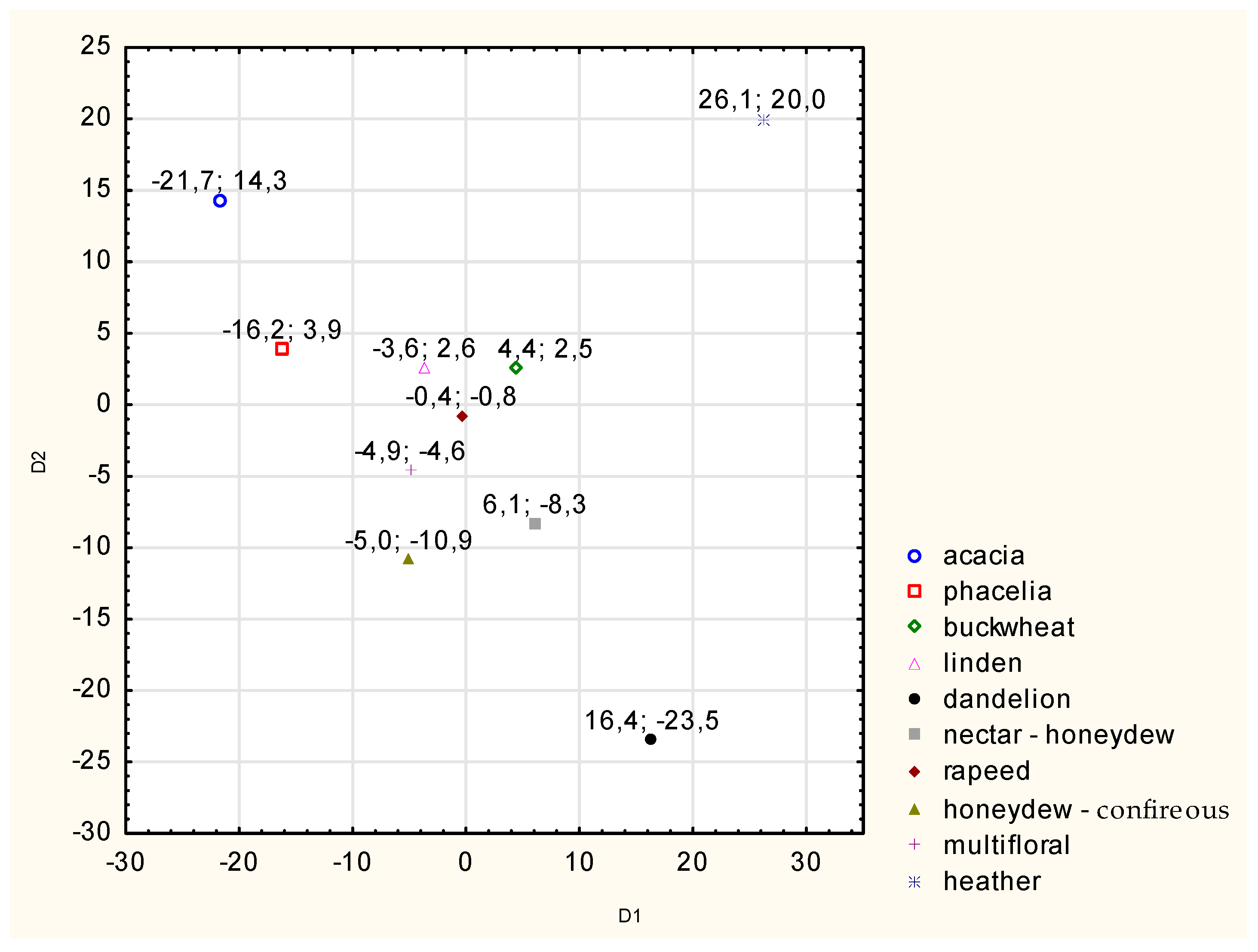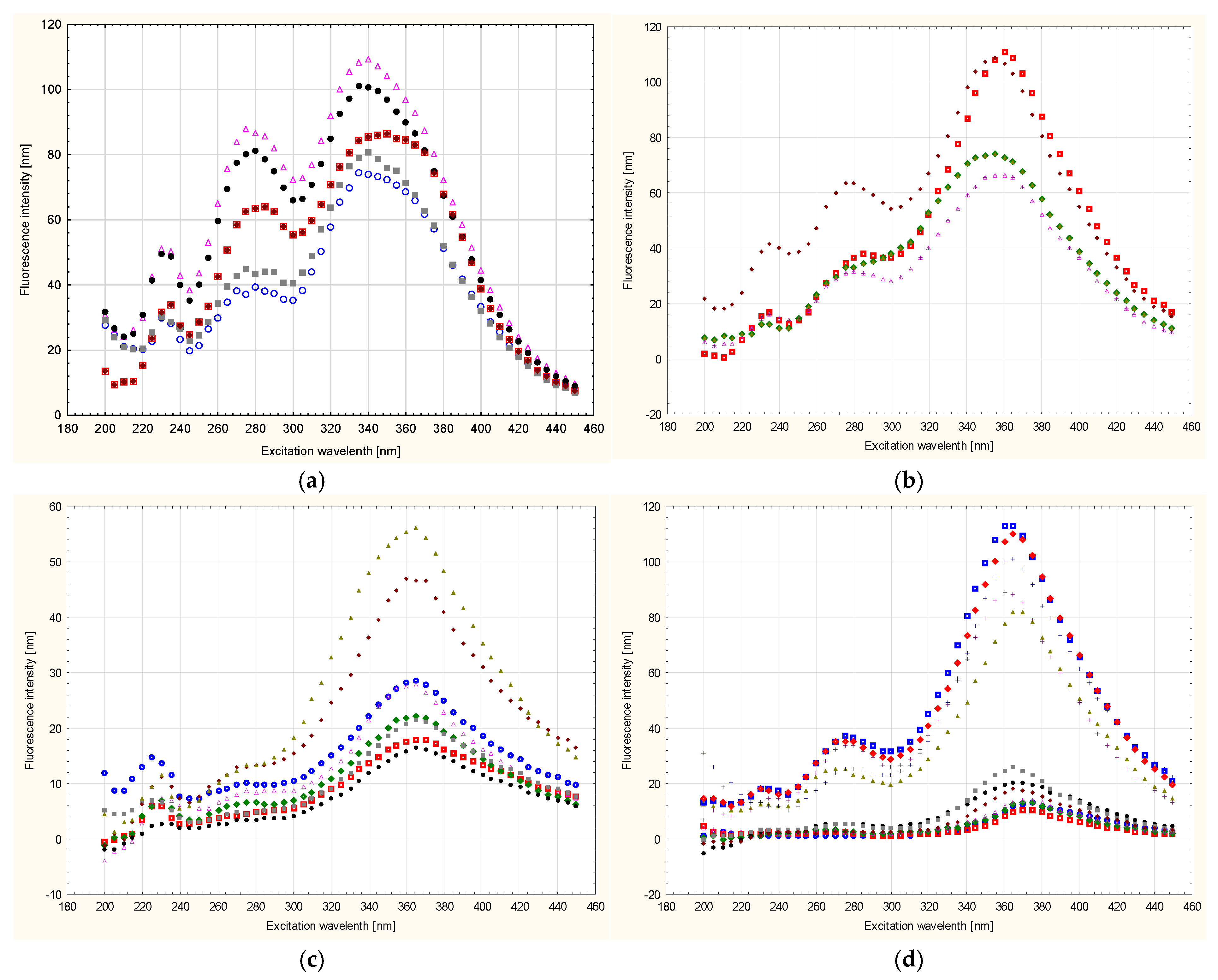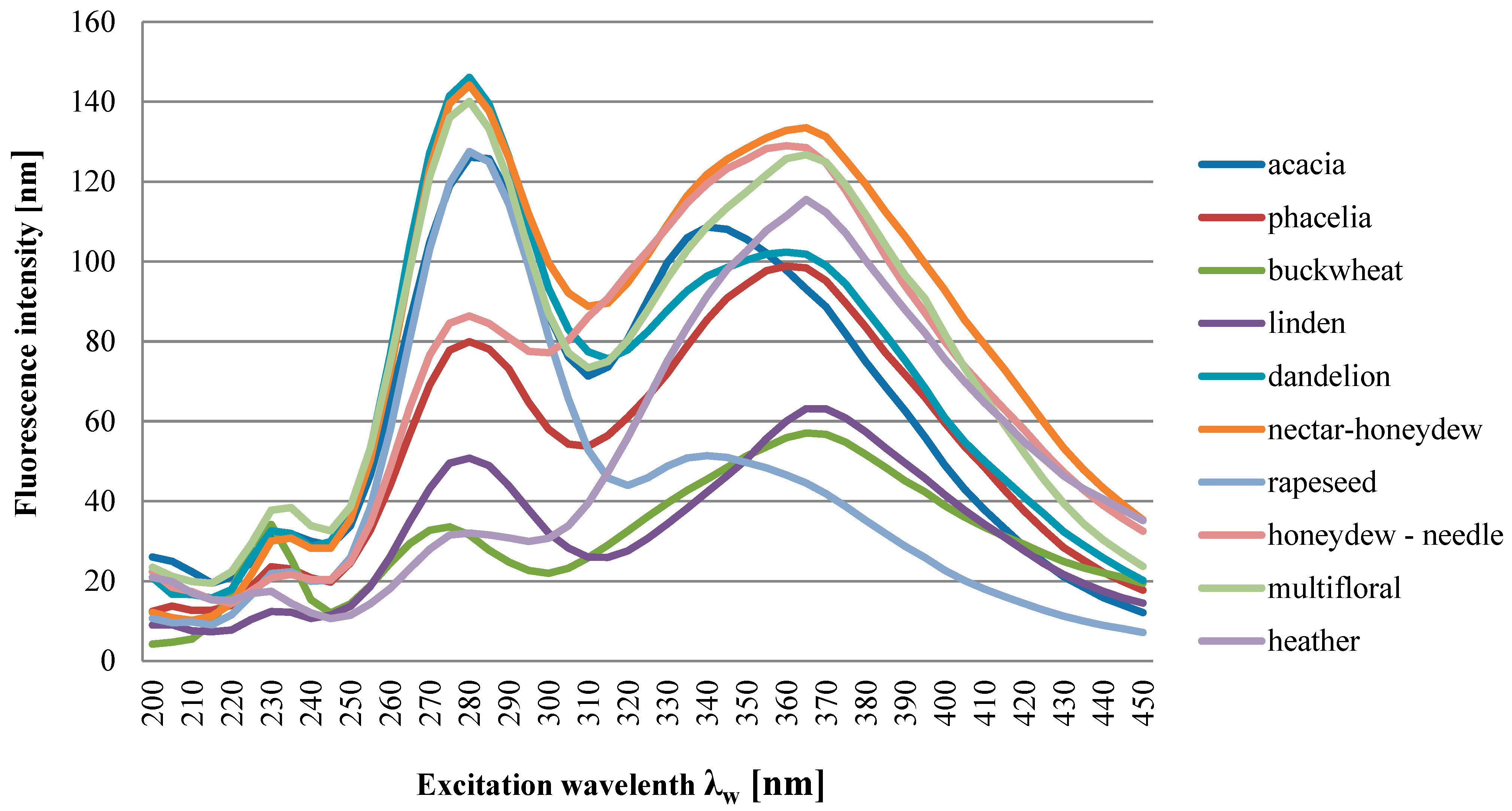The Use of Fluorescence Spectrometry Combined with Statistical Tools to Determine the Botanical Origin of Honeys
Abstract
1. Introduction
2. Materials and Methods
- A Hitachi F-7000 fluorescence spectrophotometer, Tokyo, Japan;
- A specially constructed adapter for measuring fluorescence intensity measured from the sample surface to change its traditional measurement range.
Statistical Analysis
3. Results
3.1. Analysis of Spectra
3.2. Discrimination of Honeys by Mathematical Method
- -
- The selection of any model covering only a part of the emission band does not allow us to obtain a 100% correct classification of all honey samples;
- -
- After introducing all of the measurement points of the emission band into the model, a 100% qualification of varietal honeys was obtained at Δλ 100 nm within the entire emission band (Table 1).
- Emission excitation: 280 nm (honey: acacia, buckwheat, lime, rapeseed, multifloral);
- Emission excitation: 285 nm (honey: phacelia, dandelion, nectar–honeydew).
4. Discussion
5. Conclusions
Author Contributions
Funding
Data Availability Statement
Conflicts of Interest
References
- Directive2014/63/EU of the European Parliament and of the Council of 15 May 2014 amending Council Directive 2001/110/EC Relating to Honey. Available online: https://eur-lex.europa.eu/legal-content/EN/TXT/?uri=celex%3A32014L0063 (accessed on 14 October 2024).
- Escuredo, O.; Rodríguez-Flores, M.S.; Rojo-Martínez, S.; Seijo, M.C. Contribution to the Chromatic Characterization of Unifloral Honeys from Galicia (NW Spain). Foods 2019, 8, 233. [Google Scholar] [CrossRef]
- Bogdanov, S. Honey as Nutrient and Functional Food: A Review. Book of Honey (Chapter 8). Available online: https://freethebees.ch/wp-content/uploads/2020/06/HoneyNutrientFunctional.pdf (accessed on 14 October 2024).
- Biswas, A.; Chaudchari, S. Exploring the role of NIR spectroscopy in quantifying and verifying honey authenticity: A review. Food Chem. 2024, 445, 138712. [Google Scholar] [CrossRef]
- Quintanilla-López, J.E.; Lebrón-Aguilar, R.; Soria, A.C. Volatile fingerprinting by solid-phase microextraction mass spectrometry for rapid classification of honey botanical source. LWT 2022, 169, 114017. [Google Scholar] [CrossRef]
- Biswas, A.; Naresh, K.S.; Jaygadkar, S.S.; Chaudhari, S.R. Enabling honey quality and authenticity with NMR and LC-IRMS based platform. Food Chem. 2023, 416, 135825–135838. [Google Scholar] [CrossRef]
- Bodor, R.; Kovacs, Z.; Benedek, C.; Hitka, G.; Behling, H. Origin identification of hungarian honey using melissopalynology, physicochemical analysis, and near infrared spectroscopy. Molecules 2021, 26, 7274. [Google Scholar] [CrossRef]
- Da Silva, P.M.; Gauche, C.; Gonzaga, L.V.; Costa, A.C.O.; Fett, R. Honey: Chemical composition, stability and authenticity. Food Chem. 2016, 196, 309–323. [Google Scholar] [CrossRef]
- Dong, H.; Xiao, K.; Xian, Y.; Wu, Y. Authenticity determination of honeys with non-extractable proteins by means of elemental analyzer (EA) and liquid chromatography (LC) coupled to isotope ratio mass spectroscopy (IRMS). Food Chem. 2018, 240, 717–724. [Google Scholar] [CrossRef]
- Gan, Z.; Yang, Y.; Li, J.; Wen, X.; Zhu, M.; Jiang, Y.; Ni, Y. Using sensor and spectral analysis to classify botanical origin and determine adulteration of raw honey. J. Food Eng. 2016, 178, 151–158. [Google Scholar] [CrossRef]
- Machado, A.M.; Miguel, M.G.; Vilas-Boas, M.; Figueiredo, A.C. Honey Volatiles as a Fingerprint for Botanical Origin—A Review on their Occurrence on Monofloral Honeys. Molecules 2020, 25, 374. [Google Scholar] [CrossRef]
- Żak, N.; Wilczyńska, A. The Importance of Testing the Quality and Authenticity of Food Products: The Example of Honey. Foods 2023, 12, 3210. [Google Scholar] [CrossRef]
- Zhang, X.-H.; Gu, H.-W.; Liu, R.-J.; Qing, X.-D.; Nie, J.-F. A comprehensive review of the current trends and recent advancements on the authenticity of honey. Food Chem. 2023, 19, 100850. [Google Scholar] [CrossRef]
- Tsagkaris, A.S.; Koulis, G.A.; Danezis, G.P.; Martakos, I.; Dasenaki, M.; Georgiou, C.A.; Thomaidis, N.S. Honey authenticity: Analytical techniques, state of the art and challenges. RSC Adv. 2021, 11, 11273–11294. [Google Scholar] [CrossRef]
- Guzelmeric, E.; Ciftci, I.; Yuksel, P.I.; Yesilada, E. Importance of chromatographic and spectrophotometric methods in determining authenticity, classification and bioactivity of honey. LWT 2020, 132, 109921. [Google Scholar] [CrossRef]
- Antônio, D.C.; de Assis, D.C.S.; Botelho, B.G.; Sena, M.M. Detection of adulterations in a valuable Brazilian honey by using spectrofluorimetry and multiway classification. Food Chem. 2022, 370, 131064. [Google Scholar] [CrossRef]
- Rahman, M.M.; Bui, M.V.; Shibata, M.; Nakazawa, N.; Rithu, M.N.A.; Yamashita, H.; Sadayasu, K.; Tsuchiyama, K.; Nakauchi, S.; Hagiwara, T.; et al. Rapid noninvasive monitoring of freshness variation in frozen shrimp using multidimensional fluorescence imaging coupled with chemometrics. Talanta 2021, 224, 121871. [Google Scholar] [CrossRef]
- Gu, H.; Huang, X.; Chen, Q.; Sun, Y.; Lv, R. A feasibility study for rapid evaluation of emulsion oxidation using synchronous fluorescence spectroscopy coupled with chemometrics. Spectrochim. Acta Part A Mol. Biomol. Spectrosc. 2022, 265, 120337. [Google Scholar] [CrossRef]
- Ruoff, K.; Iglesias, M.T.; Luginbühl, W.; Bosset, J.O.; Bogdanov, S.; Amado, R. Quantitative analysis of physical and chemical measurands in honey by mid-infrared spectrometry. Eur. Food Res. Technol. 2005, 223, 22–29. [Google Scholar] [CrossRef]
- Ruoff, K.; Karoui, R.; Dufour, E.; Luginbühl, W.; Bosset, J.O.; Bogdanov, S.; Amadò, R. Authentication of the botanical origin of honey by front-face fluorescence spectroscopy, a preliminary study. J. Agric. Food Chem. 2005, 53, 1343–1347. [Google Scholar] [CrossRef]
- Ruoff, K.; Luginbühl, W.; Künzli, R.; Bogdanov, S.; Bosset, J.O.; von der Ohe, K.; von der Ohe, W.; Amadò, R. Authentication of the botanical and geographical origin of honey by front-face fluorescence spectroscopy. J. Agric. Food Chem. 2006, 54, 6858–6866. [Google Scholar] [CrossRef]
- Wilczyńska, A.; Żak, N. The Use of Fluorescence Spectrometry to Determine the Botanical Origin of Filtered Honeys. Molecules 2020, 25, 1350. [Google Scholar] [CrossRef]
- Żak, N.; Wilczyńska, A.; Przybyłowski, P. The use of fluorescence spectroscopy to assess the degree of overheating of honey. Folia Pomer. Univ. Technol. Stetin. Agric. Aliment. Pisc. Zootech. 2018, 340, 131–142. [Google Scholar] [CrossRef]
- Gu, H.; Hu, L.; Dong, Y.; Chen, Q.; Wei, Z.; Lv, R. Evolving trends in fluorescence spectroscopy techniques for food quality and safety: A review. J. Food Comp. Anal. 2024, 131, 106212. [Google Scholar] [CrossRef]
- Dankowska, A. Advances in Fluorescence Emission Spectroscopy for Food Authenticity Testing. In Woodhead Publishing Series in Food Science, Technology and Nutrition, Advances in Food Authenticity Testing; Gerard, D., Ed.; Woodhead Publishing: Sawston, UK, 2016; pp. 117–145. [Google Scholar] [CrossRef]
- Sikorska, E.; Khmelinskii, I.; Sikorski, M. Fluorescence spectroscopy and imaging instruments for food quality evaluation. In Woodhead Publishing Series in Food Science, Technology and Nutrition, Evaluation Technologies for Food Quality; Jian, Z., Xichang, W., Eds.; Woodhead Publishing: Sawston, UK, 2019; pp. 491–533. [Google Scholar] [CrossRef]
- Hassoun, A.; Sahar, A.; Lakhal, L.; Aït-Kaddour, A. Fluorescence spectroscopy as a rapid and non-destructive method for monitoring quality and authenticity of fish and meat products: Impact of different preservation conditions. LWT 2019, 103, 279–292. [Google Scholar] [CrossRef]
- Wu, Q.; Geng, T.; Yan, M.-L.; Peng, Z.-X.; Chen, Y.; Lv, Y.; Yin, X.-L.; Gu, H.-W. Geographical origin traceability and authenticity detection of Chinese red wines based on excitation-emission matrix fluorescence spectroscopy and chemometric methods. J. Food Comp. Anal. 2024, 125, 105763. [Google Scholar] [CrossRef]
- Durán Merás, I.; Domínguez Manzano, J.; Airado Rodríguez, D.; Muñoz de la Peña, A. Detection and quantification of extra virgin olive oil adulteration by means of autofluorescence excitation-emission profiles combined with multi-way classification. Talanta 2018, 178, 751–762. [Google Scholar] [CrossRef]
- Ríos-Reina, R.; Ocaña, J.A.; Azcarate, S.M.; Pérez-Bernal, J.L.; Villar-Navarro, M.; Callejón, R.M. Excitation-emission fluorescence as a tool to assess the presence of grape-must caramel in PDO wine vinegars. Food Chem. 2019, 287, 115–125. [Google Scholar] [CrossRef]
- Fang, H.; Wang, T.; Chen, L.; Wang, X.-Z.; Wu, H.-L.; Chen, Y.; Yu, R.-Q. Rapid authenticity identification of high-quality Wuyi Rock tea by multidimensional fluorescence spectroscopy coupled with chemometrics. J. Food Comp. Anal. 2024, 135, 106632. [Google Scholar] [CrossRef]
- Yuan, Y.-Y.; Wang, S.-T.; Wang, J.-Z.; Cheng, Q.; Wu, X.-J.; Kong, D.-M. Rapid detection of the authenticity and adulteration of sesame oil using excitation-emission matrix fluorescence and chemometric methods. Food Contr. 2020, 112, 107145. [Google Scholar] [CrossRef]
- Nikolova, K.; Eftimov, T.; Aladjadjiyan, A. Fluorescence Spectroscopy as Method for Quality Control of Honey. Adv. Res. 2014, 2, 95–108. [Google Scholar] [CrossRef]
- Hao, S.; Li, J.; Liu, X.; Yuan, J.; Yuan, W.; Tian, Y.; Xuan, H. Authentication of acacia honey using fluorescence spectroscopy. Food Contr. 2021, 130, 108327. [Google Scholar] [CrossRef]
- Chen, Q.; Qi, S.; Li, H.; Han, X.; Ouyang, Q.; Zhao, Q. Determination of rice syrup adulterant concentration in honey using three-dimensional fluorescence spectra and multivariate calibrations. Spectrochim. Acta Part A Mol. Biomol. Spectrosc. 2014, 131, 177–182. [Google Scholar] [CrossRef]
- Santana, J.E.G.; Coutinho, H.D.M.; da Costa, J.G.M.; Menezes, J.M.C.; Pereira Teixeira, R.N. Fluorescent characteristics of bee honey constituents: A brief review. Food Chem. 2021, 362, 130174. [Google Scholar] [CrossRef]
- Lastra-Mejías, M.; Torreblanca-Zanca, A.; Aroca-Santos, R.; Cancilla, J.C.; Izquierdo, J.G.; Torrecilla, J.S. Characterization of an array of honeys of different types and botanical origins through fluorescence emission based on LEDs. Talanta 2018, 185, 196–202. [Google Scholar] [CrossRef]
- Sergiel, I.; Pohl, P.; Biesaga, M.; Mironczyk, A. Suitability of three-dimensional synchronous fluorescence spectroscopy for fingerprint analysis of honey samples with reference to their phenolic profiles. Food Chem. 2014, 145, 319–326. [Google Scholar] [CrossRef]
- Dramićanin, T.; Lenhardt Acković, L.; Zeković, I.; Dramićanin, M.D. Detection of Adulterated Honey by Fluorescence Excitation-Emission Matrices. J. Spectrosc. 2018, 2018, 8395212. [Google Scholar] [CrossRef]
- Gębala, S. Measurements of solution fluorescence–A new concept. Opt. Appl. 2009, 39, 391–399. [Google Scholar]
- Gębala, S.; Przybyłowski, P. Sposób Identyfikacji Odmian Miodu. Polska Patent 214784, 15 March 2010. [Google Scholar]
- Parri, E.; Santinami, G.; Domenici, V. Front-Face Fluorescence of Honey of Different Botanic Origin: A Case Study from Tuscany (Italy). Appl. Sci. 2020, 10, 1776. [Google Scholar] [CrossRef]






| Honey | % Correct Classification | Acacia | Phacelia | Buckwheat | Linden | Dandelion | Nectar–Honeydew | Rapeseed | Honeydew–Confireous | Multifloral | Heather |
|---|---|---|---|---|---|---|---|---|---|---|---|
| acacia | 100 | 6 | 0 | 0 | 0 | 0 | 0 | 0 | 0 | 0 | 0 |
| phacelia | 100 | 0 | 6 | 0 | 0 | 0 | 0 | 0 | 0 | 0 | 0 |
| buckwheat | 100 | 0 | 0 | 8 | 0 | 0 | 0 | 0 | 0 | 0 | 0 |
| linden | 100 | 0 | 0 | 0 | 12 | 0 | 0 | 0 | 0 | 0 | 0 |
| dandelion | 100 | 0 | 0 | 0 | 0 | 6 | 0 | 0 | 0 | 0 | 0 |
| Nectar–honeydew | 100 | 0 | 0 | 0 | 0 | 0 | 5 | 0 | 0 | 0 | 0 |
| rapeseed | 100 | 0 | 0 | 0 | 0 | 0 | 0 | 10 | 0 | 0 | 0 |
| Honeydew–needle | 100 | 0 | 0 | 0 | 0 | 0 | 0 | 0 | 6 | 0 | 0 |
| multifloral | 100 | 0 | 0 | 0 | 0 | 0 | 0 | 0 | 0 | 14 | 0 |
| heather | 100 | 0 | 0 | 0 | 0 | 0 | 0 | 0 | 0 | 0 | 8 |
| Canonical Variables | Honey | |||||||||
|---|---|---|---|---|---|---|---|---|---|---|
| Acacia | Phacelia | Buckwheat | Linden | Dandelion | Nectar–Honeydew | Rapeseed | Honeydew–Confireous | Multifloral | Heather | |
| Averages of Canonical Variates | ||||||||||
| D1 | −21.71 | −16.19 | 4.434 | −3.644 | 16.38 | 6.091 | −0.367 | −4.99 | −4.901 | 26.144 |
| D2 | 14.3 | 3.88 | 2.54 | 2.564 | −23.47 | −8.336 | −0.778 | −10.86 | −4.607 | 19.975 |
| Emission Band | Fluorescence Intensity | F1 (Discriminant Function Coefficients) | Square 1× Fluorescence Intensity | F2 (Discriminant Function Coefficients) | Square 2× Fluorescence Intensity |
|---|---|---|---|---|---|
| Free term | - | −3.664 | −3.664 | 2.677 | 2.677 |
| 200.000 | −0.502 | 0.079 | |||
| 205.000 | −0.717 | −0.577 | |||
| 210.000 | 1.398 | 0.927 | |||
| 215.000 | −1.146 | −1.452 | |||
| 220.000 | 1.239 | 1.299 | |||
| 225.000 | 1.425 | 0.840 | |||
| 230.000 | 0.824 | −0.461 | |||
| 235.000 | −2.946 | −2.929 | |||
| 240.000 | −0.666 | 4.322 | |||
| 245.000 | 3.522 | −1.546 | |||
| 250.000 | −0.464 | 0.131 | |||
| 255.000 | −1.920 | −0.054 | |||
| 260.000 | −0.696 | −2.729 | |||
| 265.000 | −2.201 | 2.347 | |||
| 270.000 | 1.950 | 1.718 | |||
| 275.000 | 0.763 | −3.293 | |||
| 280.000 | 2.151 | 1.787 | |||
| 285.000 | −1.074 | 0.707 | |||
| 290.000 | 0.056 | −0.231 | |||
| 295.000 | −3.589 | −2.249 | |||
| 300.000 | 1.211 | −0.335 | |||
| 305.000 | 2.889 | 3.227 | |||
| 310.000 | −1.094 | −1.092 | |||
| 315.000 | −1.987 | −2.966 | |||
| 320.000 | −0.798 | 0.206 | |||
| 325.000 | 4.240 | 1.035 | |||
| 330.000 | −0.729 | 4.727 | |||
| 335.000 | −1.849 | −3.363 | |||
| 340.000 | 1.717 | −1.704 | |||
| 345.000 | 1.834 | 4.251 | |||
| 350.000 | −3.414 | −2.002 | |||
| 355.000 | −4.152 | −2.765 | |||
| 360.000 | 4.684 | 1.588 | |||
| 365.000 | −0.456 | 0.161 | |||
| 370.000 | 6.187 | 3.346 | |||
| 375.000 | −4.361 | −5.826 | |||
| 380.000 | −4.968 | 2.121 | |||
| 385.000 | 5.438 | 3.984 | |||
| 390.000 | −2.449 | −3.884 | |||
| 395.000 | 0.741 | 3.593 | |||
| 400.000 | −5.072 | −4.049 | |||
| 405.000 | 4.449 | −0.149 | |||
| 410.000 | 2.754 | 2.695 | |||
| 415.000 | −6.915 | −0.923 | |||
| 420.000 | 2.698 | −1.150 | |||
| 425.000 | 3.570 | −0.825 | |||
| 430.000 | −1.298 | 2.171 | |||
| 435.000 | 4.690 | −4.005 | |||
| 440.000 | −1.523 | 0.744 | |||
| 445.000 | −8.798 | −0.297 | |||
| 450.000 | 5.980 | 3.072 | |||
| TOTAL = D1 | TOTAL = D2 |
| Botanical Origin of Honey | Excitation Wavelength Δλw for Maximum Fluorescence Intensity of Varietal Honeys [nm] | ||
|---|---|---|---|
| I Excitation | II Excitation | III Excitation | |
| acacia | 235 | 280 | 340 |
| phacelia | 240 | 285 | 360 |
| buckwheat | 235 | 280 | 370 |
| linden | 235 | 280 | 370 |
| dandelion | 235 | 285 | 365 |
| nectar–honeydew | 235 | 285 | 360 |
| rapeseed | 235 | 280 | 340 |
| honeydew–needle | 235 | absence | 360 |
| multifloral | 235 | 280 | 365 |
| heather | 235 | absence | 370 |
Disclaimer/Publisher’s Note: The statements, opinions and data contained in all publications are solely those of the individual author(s) and contributor(s) and not of MDPI and/or the editor(s). MDPI and/or the editor(s) disclaim responsibility for any injury to people or property resulting from any ideas, methods, instructions or products referred to in the content. |
© 2024 by the authors. Licensee MDPI, Basel, Switzerland. This article is an open access article distributed under the terms and conditions of the Creative Commons Attribution (CC BY) license (https://creativecommons.org/licenses/by/4.0/).
Share and Cite
Wilczyńska, A.; Żak, N. The Use of Fluorescence Spectrometry Combined with Statistical Tools to Determine the Botanical Origin of Honeys. Foods 2024, 13, 3303. https://doi.org/10.3390/foods13203303
Wilczyńska A, Żak N. The Use of Fluorescence Spectrometry Combined with Statistical Tools to Determine the Botanical Origin of Honeys. Foods. 2024; 13(20):3303. https://doi.org/10.3390/foods13203303
Chicago/Turabian StyleWilczyńska, Aleksandra, and Natalia Żak. 2024. "The Use of Fluorescence Spectrometry Combined with Statistical Tools to Determine the Botanical Origin of Honeys" Foods 13, no. 20: 3303. https://doi.org/10.3390/foods13203303
APA StyleWilczyńska, A., & Żak, N. (2024). The Use of Fluorescence Spectrometry Combined with Statistical Tools to Determine the Botanical Origin of Honeys. Foods, 13(20), 3303. https://doi.org/10.3390/foods13203303







